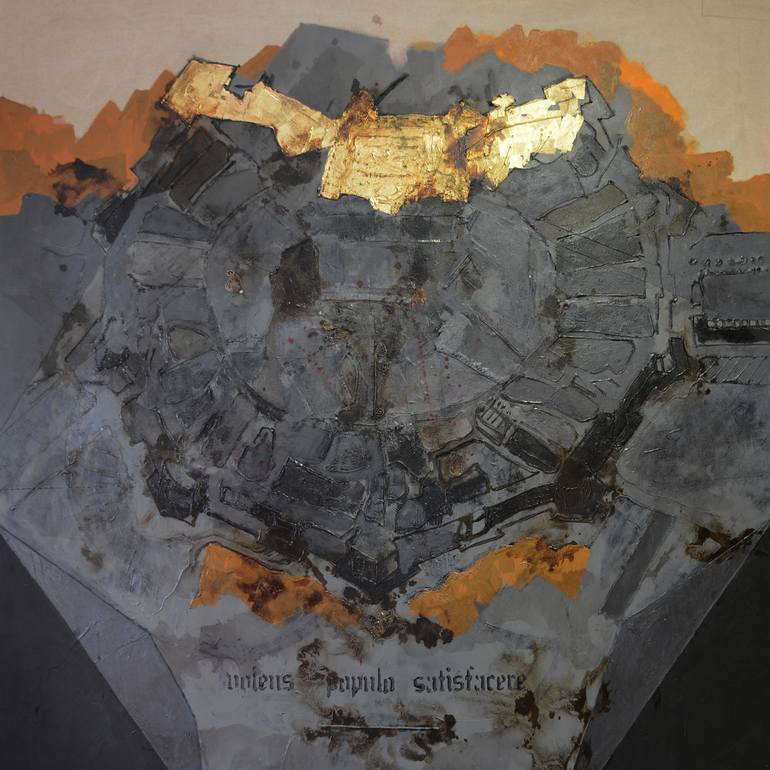


VIEW IN MY ROOM
"Vulens Populo Satisfacere"Composition N°514 Painting
France
Painting, Acrylic on Canvas
Size: 78.7 W x 78.7 H x 1.6 D in
Ships in a Crate
Artist Recognition

Artist featured in a collection
About The Artwork
Volens populo satisfacere Feuille d’or et acrylique sur toile 200x200cm Paris 2016 Ce que le spectateur voit sur la toile c'est, une nouvelle fois, un plan : la ville de Milan telle qu'elle était à la fin du XVème siècle, à l'époque de la construction de l'Oratoire de la Basilique Sant'Ambrogio par Guiniforte Solari. Le regard du spectateur est d'abord attiré dans la partie supérieure de la toile, par la figure géométrique recouverte de feuille d'or représentant le Château des Sforza. Forteresse érigée dans la seconde moitié du Xvème siècle par Francesco Sforza, Duc de Milan, elle symbolise l'avènement de la République Ambrosienne, après la chute de la dynastie des Visconti. Suivant un mouvement vertical, l'oeil du spectateur se déplace vers la partie inférieure de la toile pour déchiffrer l'inscription latine disposée symétriquement au château : « Volens populo satisfacere ». C'est alors que la signification du tableau bascule et qu'une nouvelle temporalité est convoquée dans et par l'image : ces mots que le spectateur déchiffre sont le déclencheur de la passion du Christ telle que la rapporte saint Marc dans son Évangile. Saint Marc raconte que la foule déchaînée demandait à ce qu'on relâchât le meurtrier Barabbas au lieu de Jésus qu'elle voulait faire crucifier. Ainsi, « Pilate, voulant satisfaire la foule, leur relâcha Barabbas ; et, après avoir fait battre de verges Jésus, il le livra pour être crucifié » (Évangile selon Saint Marc, 15:15). L'épisode de la flagellation du Christ apparaît, dans l'oeuvre du peintre, au travers des boursouflures de peinture représentant le paysage urbain. La matérialité de ces couches de peinture reprend l'aspect des cicatrices laissées par la violence du fouet. La toile se fait peau mais elle est aussi ce mur de l'Oratoire d'où ont été arrachées les fresques italiennes. Dans un mouvement ascendant reliant la matérialité et l'intellectualité, l'artiste signifie, par les moyens mêmes de sa peinture – la trace du pinceau chargé de matière – , cette triple histoire : le récit de la flagellation du Christ, celui de la ville de Milan au Xvème siècle, celui de l'Oratoire de la Passion, outragé au XIXème siècle.
Details & Dimensions
Painting:Acrylic on Canvas
Original:One-of-a-kind Artwork
Size:78.7 W x 78.7 H x 1.6 D in
Frame:Not Framed
Ready to Hang:Not applicable
Packaging:Ships in a Crate
Shipping & Returns
Delivery Time:Typically 5-7 business days for domestic shipments, 10-14 business days for international shipments.
Handling:Ships in a wooden crate for additional protection of heavy or oversized artworks. Crated works are subject to an $80 care and handling fee. Artists are responsible for packaging and adhering to Saatchi Art’s packaging guidelines.
Ships From:France.
Have additional questions?
Please visit our help section or contact us.
The art of Rodolfo Oviedo Vega is one of paradox and certain contradictions. His paintings can seem at first glance to be heavy, even opaque on the canvas, yet on closer inspection they became surprisingly varied in their textures. Parts of some works have an appealing heft, with collage elements and layers of oil paint worked into a thick impasto, while others can seem as light and delicate as fallen leaves. His compositions can seem purely abstract, and his basic visual language has remained rooted in abstraction for most of his career. Yet figuration keeps poking through in ways that give his work complexity and an enigmatic charm. The abstract forms of some works recall portraiture, while the perspectives and horizon line in others harks back to the landscape-painting tradition. Architectural elements frequently appear in Oviedo Vega’s work – railings, windows, arches, often in sombre colours that emphasise their geometric armatures – and show his interest in urban space and construction. Far from pure abstraction, these works often lead us into explorations of the aesthetic possibilities of buildings, with their multiple planes and volumes, and the architectural forms of contemporary cities, which, in Oviedo Vega’s hands, can look familiar to any city dweller yet also strange and even a bit alienating. This engagement with urban architecture also suggests a connection to his native El Salvador, the most urbanised country of Latin America. Oviedo Vega inhabits and plays out these contradictions in his work, without – to his great credit as an artist – ever trying to resolve them into neat packages, creating instead works that are complex, multi-layered and deeply human. Oviedo Vega has travelled all over the world, absorbing experiences and artistic influences that are sometimes reflected in his work, and living for a time in southern India and later Paris, where he lives and works today. His paintings are often better described as mixed-media collages, incorporating materials including sand, coconut bark, banana leaves and red wine. Roger Atwood. Rodolfo Oviedo Vega is one of those great travelers whose tales of adventures amaze us so much as they fascinate us. Adventurer from Central America, from El Salvador to Chile, going through the archipelago of San Blas, the artist has traveled along India living in Kerala and then in the Himalaya. He has crossed Europe and exposed his work in Paris, Madrid, Tallinn and Milan.
Artist Recognition

Artist featured by Saatchi Art in a collection
Thousands Of Five-Star Reviews
We deliver world-class customer service to all of our art buyers.
Global Selection
Explore an unparalleled artwork selection by artists from around the world.
Satisfaction Guaranteed
Our 14-day satisfaction guarantee allows you to buy with confidence.
Support An Artist With Every Purchase
We pay our artists more on every sale than other galleries.
Need More Help?